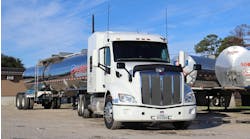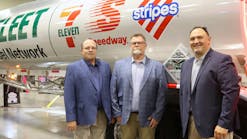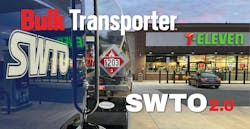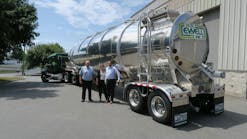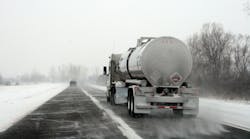Less than 7,000 of the 52,000 drivers with at least one violation in the Federal Motor Carrier Safety Administration’s Drug & Alcohol Clearinghouse as of Jan. 1 had completed the return-to-duty (RTD) process, according to FMCSA division administrator Dan Meyer, who recently spoke to National Tank Truck Carriers (NTTC) members.
That’s not a number with which he was real comfortable.
“There are over 45,000 drivers who are still prohibited within the system,” Meyer said during the February webinar about the new Clearinghouse present by FMCSA and NTTC. “If that number doesn’t scare you into making sure you’re running your queries, I don’t know what it would take, because this is a staggering number to me.
“That means almost 35,000 drivers haven’t even begun the return-to-duty process in any form or fashion. And there are 7,000 who have been determined eligible for return-to-duty testing, but they’re just attempting to find a prospective employer to work with to get that test done.”
Meyer reviewed Clearinghouse basics and first-year statistics before giving way to fellow speaker Dr. Nancy King, the medical director for The Occupational Health Center Inc., who has served as a medical review officer (MRO) for more than 30 years. She covered who’s required to report to the Clearinghouse, and under what circumstances, before the two took questions during the webinar sponsored by Act One and Cottingham & Butler.
Mandatory use of the Drug & Alcohol Clearinghouse began Jan. 6, 2020, so NTTC’s presentation included approximately one year of data, and highlighted lessons learned during the first year. Clearinghouse functions include maintaining and recording commercial driver’s license (CDL)-holder U.S. Department of Transportation (DOT) drug and alcohol violations as reported by employers and MROs, tracking the return-to-duty process, and enabling pre-employment and annual “queries,” or electronic checks, by motor carriers.
Queries
There are two types of queries: Full and limited. Drivers must provide consent through the Clearinghouse for full queries. “That’s the only way the full query can be conducted,” said Meyer, emphasizing it’s also critical to select and identify new-hire queries as pre-employment checks in order to receive the 30-day look back option, which allows employers to review any new information added to the database within 30 days of the query.
Limited queries are, at a minimum, conducted once per year. “You can conduct the full query in lieu of the limited, but you must have either one done every year on an annual basis,” said Meyer. Driver consent, which is provided outside the Clearinghouse, should be retained in a driver qualification file, he advised.
“By now, since the program has been in effect a full year, you should have done an annual query on every one of the drivers you have on the road, if they are not a new or recent hire with a pre-employment query within the last year,” Meyer said.
Statistics
Clearinghouse data is reported on a monthly basis. Based on user registrations as of Jan. 1, the system included nearly 1.6 million driver accounts—out of about 3 million CDL drivers in the U.S.—and 197,212 employer accounts. “That’s a little low,” Meyer said. “For all of the employers out there who hire CDL drivers, we would expect that figure to be higher, so we know there are still some people out there who need to sign up for their account.”
Total unique accounts in the Clearinghouse, including MROs, consortium/third-party administrators (C/TPAs) and substance abuse professionals (SAPs) number about 1.77 million.
A total of 4.2 million queries were conducted during the first year. Most of them, about 2.7 million, were limited queries, which, with a driver’s permission, can be run at any time, revealing if they’ve applied elsewhere.
The system had recorded 54,955 drug violations by Jan. 1, compared to only 1,203 alcohol violations. Drug violations are categorized as actual knowledge of a violation, drug test refusal or positive drug test, which made up the largest percentage of violations at 45,822. Violations are discovered during different types of tests, including pre-employment, post-accident and random, and pre-employment violations made up the highest percentage, with more than 28,000 mostly drug-related violations entered in the system.
Random testing violations were a close second, with nearly 21,000.
Positive drug tests accounted for 82% of the total violations reported, and more than half of those, 29,511, were positive marijuana tests. Cocaine, with 7,940 positive tests, was a distance second, followed by methamphetamines (5,187) and amphetamines (4,953). “It’s important to understand some drivers will test positive for more than one substance, or some drivers will test positive again on a later test,” Meyer said.
And of the 51,988 drivers with at least one violation, only a handful were back on the road.
Return to duty
Employers are required to immediately remove drug and alcohol violators from DOT-regulated safety-sensitive functions, and violators must complete the RTD process before they are permitted to return to these functions with a current or new employer. Whether or not a driver is terminated or afforded a rehabilitation opportunity is determined by employer policies.
Successful RTD completion in the Clearinghouse includes six steps:
- Step 1 – Driver requests SAP in Clearinghouse
- Step 2 – SAP accepts driver’s request
- Step 3 – An initial evaluation, as per 49 CFR subpart 40.293, or its equivalent
- Step 4 – Follow-up evaluation, as per subpart 40.301, or its equivalent
- Step 5 – Upload of negative result from RTD test by employer or C/TPA
- Step 6 – Date of assigned follow-up testing plan (not the actual plan) recorded in Clearinghouse
Meyer said it’s important for drivers to reach out to an SAP before the first step to establish a relationship and ensure the SAP is willing and able to take on the driver. SAPs should not, he said, find out a driver wants to use them through the Clearinghouse. “Once they send that request to the SAP, it is difficult to get it changed, because the intent of the mandate is to prevent the driver from doing SAP shopping,” he explained.
After identifying an SAP, the driver then goes into the system to officially request them, and the Clearinghouse creates a date stamp. The SAP then accepts the request and begins the initial assessment, and those dates also are entered in the system.
“Once they have determined the driver eligible for return-to-duty testing, they’ll enter that date,” Meyer continued. “Then the driver can go and take the return-to-duty test, and then the MRO will enter the negative return-to-duty test. Then the follow-up testing plan is to be completed outside of the system with a new employer. Remember, only an employer or C/TPA can upload the data from a negative return-to-duty test.”
Challenges
Drivers can challenge information in the system, but they’re prohibited from challenging the accuracy of test results or refusals. Petitions are submitted by drivers via FMCSA’s DataQs system at dataqs.fmcsa.dot.gov.
Drivers should contact their MRO if they believe a result should be changed or have other questions about a positive test. Other challenges regarding information in the Clearinghouse are submitted through the National Consumer Complaint Database (NCCDB).
A prospective driver deciding not to take a pre-employment test is not considered a refusal until the testing process commences. “They can be sitting in the lobby waiting to take the test, and then get a call from another company they really wanted to go to work for, and get up and walk out, and that’s not a refusal, because the process has not begun,” Meyer said.
Employers should not duplicate violations already entered by other users. Users can request violations they entered be removed, but the request must be approved by FMCSA. Meyer also emphasized queries only can be purchased by employers, not C/TPAs; employers should link their company name to their DOT number for identification; and CDL numbers should be entered without any spaces or dashes that appear on the card.
Also, recent updates include notifications for drivers, employers and SAPs, and a new control and custody form, which uses a driver’s CDL number and state of issuance as the donor’s test identification. “It’s imperative that everyone use the new form because we’re no longer tracking social security numbers,” Meyer said.
For issues with FMCSA portal account registration, call 800-724-2811. For questions about the Clearinghouse, contact the local division office or call FMCSA at 844-955-0207, or visit clearinghouse.fmcsa.dot.gov/contact.
Reporting
Entities required to report to the Clearinghouse include prospective and current employers of CDL drivers, C/TPAs, MROs and SAPs.
Alcohol testing does not require MRO oversight, so the employer or their designated TPA must report the violation to the Clearinghouse, and alcohol confirmation tests with a concentration of 0.04 or higher must be reported. “Drivers with confirmation test levels of .02 to .039 are not in violation of Part 40, but those levels do require that driver be removed from the safety sensitive position for 24 hours prior to returning to work,” King said.
Employers also must report refusals to test. Employer-determined refusals include failure to appear at a testing location within the carrier-designated time frame, leaving a site during the process before it is completed, failure to provide a urine sample, failure to complete additional tests as directed, or failure to cooperate during the collection process.
An employer-determined alcohol test refusal includes failure to provide an adequate amount of breath or saliva.
Employers also must report “actual knowledge,” negative RTD test results and follow-up test completion. Actual knowledge, as defined in 49 CFR 382.107, means the employers knows a driver has used alcohol or a controlled substance on duty, within four hours of coming on duty or prior to post-accident testing based on direct observation of the employee, information provided by the driver’s previous employer, or a traffic citation for driver a commercial motor vehicle while under the influence of drugs or alcohol.
“Follow-up testing occurs after the individual has been returned to work, and has had a negative return to duty,” King said. “And the follow-up testing must be completed within the first 12 months following his or her return, with six unannounced follow-up tests within that 12-month period of time.”
C/TPA reporting responsibilities mirror those of the employer, King said. “You can actually designate your TPA in the Clearinghouse to perform all these responsibilities that you as a motor carrier normally would be required to do,” she reminded.
MROs like King report to the Clearinghouse verified positive drug screens, and adulterated or substituted drug screens. “We don’t have any say so in the breath alcohol,” she said. “That’s going to be entirely employer driven.”
Refusals, from an MRO standpoint, include adulterated or substituted specimens, or an individual not providing a sufficient quantity of urine within the three-hour “shy bladder” process, with no reasonable medical explanation after an evaluation. “When a donor arrives at the clinic, they have up to three hours and 40 ounces of fluid to provide a sufficient volume of urine, which is 45 milliliters,” King said. “If they are unable to provide that amount of urine after the three-hour shy bladder process, that is an MRO-determined refusal.”
Finally, SAPs—who determine the necessary rehab, and provisions for follow-up and RTD testing—must report the date their initial driver assessment was initiated, and the date when treatment was completed.
Follow-up
Q: How do CBD products impact drug testing?
King: “CBD, unfortunately, is not regulated by the FDA (U.S. Food and Drug Administration), so there is a lot of misinformation out there as far as CBD oils and potions are concerned. From a medical review officer’s standpoint, and from a federal standpoint, I am not able to give consideration in my determination about verifying a positive marijuana test whether or not somebody has used CBD. I’m not going to say CBD might not cause a positive marijuana test. I’m sure it might. However, that’s not a consideration that I can give.”
Q: What are the consequences for a company that hasn’t completed all of its annual queries?
Meyer: Clearinghouse pre-employment background checks take the place of previous, federally mandated checks, so violations come with similar repercussions, Meyer said. However, “the larger issue is, if you hired a prohibited driver, the company no longer has any defense that they could not have reasonably known the driver was prohibited, because the information is in the database. That’s going to be the bigger problem.
“When you hire that prohibited driver and we find out about it, the company now is going to be charged with hiring a prohibited driver.”
